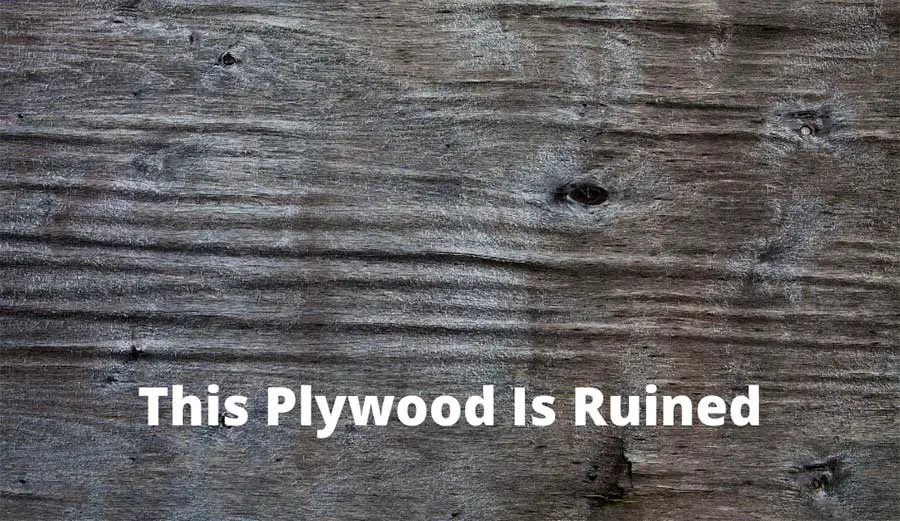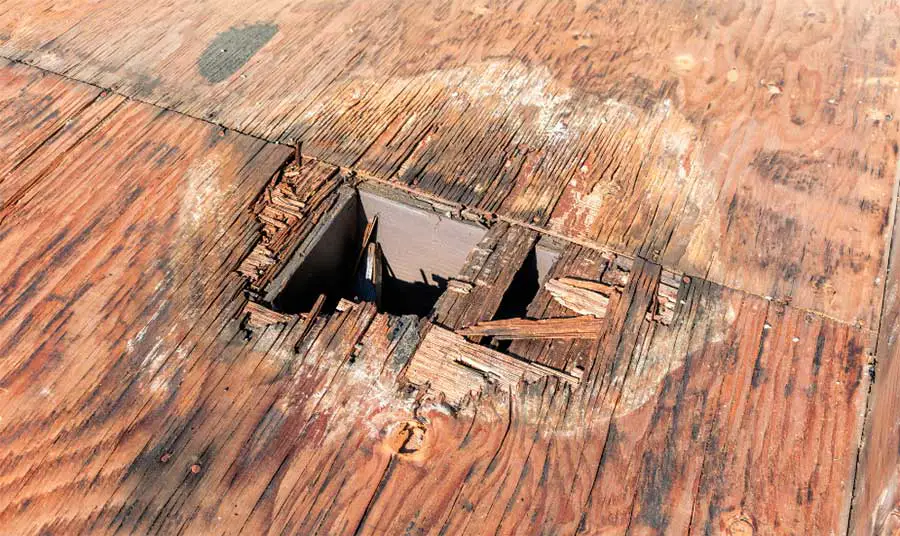I use plywood in my workshop quite a lot for making jigs and some furniture. The other day I was bringing some home from the store when I got caught in a storm. The top 3 sheets of plywood got wet and were actually soaked in water.
I thought I would share my experience and how I managed to save those sheets. This raises a question, can plywood get wet?
Plywood can get wet over short periods of time, be dried out, and still maintain its strength and finish. Prolonged exposure to rain can cause the softwood layers to de-laminate. In some plywood, the glue can deteriorate and let go.
To discover how I saved my plywood sheets, keep reading the information I have put together. First of all, let’s discuss what is plywood.
What Is Plywood?
Plywood is made from layers of thin softwood sheets glued together with alternating grain directions. The glue is usually a urea-formaldehyde or polyurethane form. The alternating layers make plywood a good strong sheet material for almost any project whether it’s furniture making or subfloor applications.
Many layers of these thin sheets are glued up to form different finished thicknesses of plywood. Plywood is mostly available in 6, 9, 12, 17, 19, 25, and 33mm thicknesses.
Be sure to read my full article that explains if MDF can be used outside. It might surprise you.
Does Rain Ruin Plywood?

A small amount of rain will not ruin plywood. A few showers of rain or a storm on your plywood will be ok as long as it is for only an hour at the most.
Be sure to see my recommendations on the best plywood for outdoors. It has saved me many hours of work.
However, leaving your plywood out in a rain event overnight is not a good idea. This will mean the layers of wood will get soaked by water which can start to affect their structural integrity.
You have to remember that plywood is simply layers of softwood glued together. While the glue is waterproof, the wood fibers are not.
If your plywood is exposed to extended periods of rain, the wood will start to swell and deform and the layers can start coming apart. While the glue is mostly waterproof, excess rain can cause the glue to fail.
Does Plywood Absorb Water?
Plywood does absorb water as it is simply layers of actual softwood fibers glued together. These softwood layers do absorb moisture in the cell walls like any other wood.
This water absorption may take several hours but water will eventually soak through the layers of the wood.
Usually, plywood comes in bundles so it may be more difficult to transport home quickly. Take a look at my article that explains how many sheets of plywood come in a bundle.
The type of plywood you have can also affect the rate at which the water will absorb. A tightly pressed A-grade plywood will be better than a cheap sheet of OSB. Some plywoods also have hardwood layers which have denser cells and can take longer to absorb water.
Plywood can handle some water.
Can Wet Plywood Be Saved?
If your plywood has only been exposed to a few hours of moisture or water then it can be saved. It may have some dark discoloring around the edges where the water has started to soak in.
The important thing is to keep it covered up and remove any excess water straight away. Once this has been done we can then discuss how we go about drying it out.
See how I straighten warped plywood and is it possible to get flat plywood.
How Do I Dry My Plywood?
Here I will let you know the steps to take in order to dry your plywood out completely. I used this same process for my plywood and it worked a treat. What we need to do here is encourage that water out and make it evaporate.
- Isolate the plywood – By isolate I mean store it inside in a dry location. Keeping it outside (even undercover) is still not the best especially if there is high humidity in the air. The wood fibers continually draw in and expel moisture from the air. The driest location you can provide will be for the best.
- Remove excess water – The first step is to remove as much excess water as possible. To do this you can use a few dry cloths or spread dry sawdust over the water to soak it up.
- Stack the sheets – Next, you need to stack individual sheets on packers or bearers of timber. The idea here is to allow as much airflow to all sides of the sheets as possible. I would use a bearer or packer every 300mm or foot so that the sheet will remain flat and not sag.
- Use a fan – Placing a few high-powered fans toward the sheets will encourage air to move over the surface quickly which will, in turn, draw out the moisture. This is why those packers are important as it allows the air to get to all sides of the plywood.
- Use some heat – If you have access to a heater of some description or even a heater with a built-in fan would be best. The idea here is to warm up the room temperate. DO NOT blow heat directly on the sheets of plywood as this could cause warping or cupping of your sheets.
- Give it some time – I would leave your sheets in this situation for a couple of days to ensure they dry out properly. If you are experiencing a lot of seasonal rain or storms over a few days, then this may take longer.
Once you have completed the above steps your plywood should be completely dry and ready for use.
How Long Does Wet Plywood Take To Dry?
Wet Plywood will dry out after 4-5 days provided it is stacked on packers and has good air circulation that can be achieved around the entire surface of the sheet.
If you are just leaving your plywood dry out without the use of a fan or heater, then it could take a couple of weeks to dry out.
Here are some other ways to cut plywood.
Are Your Plywood Sheets Ruined?
So maybe you have dried your plywood out as much as possible, but what are the signs that my plywood has been ruined and can’t be saved?
With any excess water on wooden products, you will notice dark stains throughout the sheets. This can be simple discoloration but should not affect the quality of your plywood in general.
The discoloration is usually a surface imperfection but it will take a lot of sanding to get rid of it. In some cases, you may not be able to sand it out. If you bought good plywood and you wanted to stain and finish it, then this can be a problem.
In this case, your plywood may be ruined and you might have to use it on parts that don’t require visual perfection.
The next thing to look for is warping or cupping. If your plywood has taken on a lot of water then you will most likely have severe warping or cupping in the sheets. Simply look along the surface to see if this is an issue for you.
If you are going to cut your sheet up into small parts then you may be lucky and be able to cut most of this out.
The last thing to tell if your plywood is ruined is that the edges will usually start swelling or de-laminating. The edges will also have the most severe discoloration.
In most cases, this de-laminating will only inform the edge about 50mm (2″) and you should be able to cut this off before using the sheet.
If you press on the plywood and find it spongy all through it, then your plywood has de-laminated and will be ruined.
What Kind Of Plywood Is Waterproof?
In all interior cases, you will not need waterproof plywood, although sometimes you may have an outdoor project that requires waterproof plywood.
Marine Grade Plywood or often called Marine Ply is the most waterproof plywood available which maintains a good surface finish. This form of plywood has hardwood layers instead of softwood so it will take much more exposure to water.
Marine Ply is bonded with waterproof glue, although it is a combination of this glue and the hardwood that makes it much more resilient in the wet. Some Marine plywoods are guaranteed for 15-25 years but will depend on your use and location.
Don’t be fooled thinking it is perfectly waterproof though. It is more ‘water-resistant’. It also uses waterproof glue but excessive amounts of water over time can lead to its demise.
Marine ply is not treated with any chemicals and therefore is not rot-resistant.
Best Way To Seal Plywood
Plywood will last many more years if it is properly sealed especially if you are doing an outdoor project. Here are the steps I take to get a good seal and a nice finish on plywood:
- Sand – If you have purchased a good grade of plywood then you can start with 120 grit sandpaper to sand smooth any imperfections. Pay close attention to the edges to get them as smooth as possible. If you are sealing your plywood for an indoor piece of furniture then using 180 and 240 grit sandpaper will be best.
- Wipe down – Clean down your plywood with a lint-free cloth to remove any excess dust.
- Paint or clear finish? – If you are simply painting the plywood I highly recommend this article for the best results. Continue on for a clear finish.
- Sanding Sealer – To get the best possible finish, a sanding sealer will seal the plywood and provide you with an excellent foundation for any topcoats.
- More Sanding – You should always sand after applying sanding sealer. Use 240 grit sandpaper and the plywood surface will be extremely smooth ready for a topcoat.
- Final coat – Now you may apply and polyurethane topcoat you see fit. The use of a roller is best for large surfaces. More than 1 coat may be required.
Can Plywood Get Wet During Construction?
In nearly all houses that get built, plywood is one product that is used extensively as either wall bracing or flooring in double-story dwellings.
More often than not, this plywood will get rained on before the roof is on which begs the question, can plywood get wet during construction?
Framing or structural plywood that has an A-grade glue bond can get wet during construction without adverse effects on its strength. It will stand up to quite a lot of moisture before it is affected.
It normally gets plenty of sunny days to dry out so this plywood getting wet is not too much of an issue. Although extensive rain periods can be problematic if you see the plywood edges start to de-laminate.
Looking for alternative ways to cut your plywood sheets? These 5 tools can also be used.
Conclusion – Can Plywood Get Wet?
So we have discovered what plywood is, and in most cases, your plywood will be fine to use with a medium amount of water. If however, your plywood has sat outside in the rain for a couple of days, the chances of it being any good are slim.
I hope this article was of benefit to you and helped you understand more about plywood getting wet.




